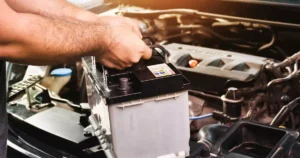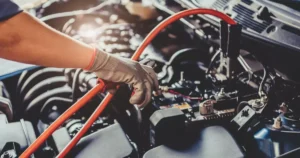A dead battery can leave you stuck, but replacing it is simple if you know how. Learning how to change a car battery helps you handle this problem safely and easily. You’ll need tools like a wire brush, safety goggles, and a socket wrench to work on the battery terminals. Be sure to follow safety precautions like wearing protective gear and keeping away metal objects. By following these steps, you can replace the battery and keep your car running.
Ready to start? Let’s jump into the step-by-step guide.
What are the Benefits of Car Battery Replacement?

Replacing your car battery is more than just swapping out a dead battery—it’s an investment in your vehicle’s health and safety. A replacement battery helps your car run well and stops problems like dimming headlights or warning lights. Replacing the battery on time keeps your vehicle working and makes it last longer.
Let’s explore more of the benefits below.
Improved Vehicle Performance
A new automotive battery gives steady power so your car starts easily and runs well. The correct replacement battery fixes problems like weak battery posts or slow starts. Clean the battery terminals with a stout wire brush or brass wire brush to make a good connection. Secure the battery in the battery tray with a hold-down OBDII memory saver to keep it from moving. This helps your car work better and last longer.
Increased Battery Efficiency
A new battery improves how well the battery cables and connections work by cutting energy loss. Put anti-corrosion grease on the positive terminal and negative terminal to prevent buildup and rust. These steps keep the energy flowing and lower stress on the engine bay.
Enhanced Safety
Old batteries can leak battery acid, which is not safe. Use protective gear like safety glasses or eye protection when doing a battery replacement. Take off plastic caps or plastic covers gently, and keep metal objects or metal jewelry far from the engine compartment. Changing a bad battery can stop overheating or electrical issues.
What Tools Do You Need for Battery Replacement?

Replacing a car battery is easy when you have the right tools. Each tool helps with specific tasks, like cleaning the battery terminals or safely installing the replacement battery. Without the right tools, you might damage the positive cable or negative cable or have bad connections. A good toolkit makes the battery replacement simple and helps your new battery last longer.
Below, we look at the tools you need and how they help with the job.
Wire Brush
A wire brush, such as a brass wire brush or carbon wire brush, is vital for cleaning corrosion from battery terminals, positive posts, and negative posts. This ensures proper contact and efficient power transfer. A clean battery tray and terminals improve electrical flow and reduce the risk of buildup.
Socket Wrench
A socket wrench is important for loosening and tightening the battery terminal clamps. It helps make sure the positive terminal and negative terminal are secure without being too tight. Using the right socket size stops damage to the clamps. If the battery posts are stuck, a terminal puller can help remove them safely.
Safety Glasses and Gloves
Safety glasses and safety gloves protect you from battery acid and sharp edges. This protective gear reduces the chance of getting hurt during the battery replacement. Always follow safety precautions, like wearing eye protection and being careful in the engine bay. Keep away from metal objects and avoid wearing metal jewelry while working.
Anti-corrosion and Dielectric Grease
Using anti-corrosion grease on the battery terminals stops moisture and rust from building up. Dielectric grease improves electrical connections and helps prevent shorts. After cleaning the terminals with a terminal cleaning tool, add a thin layer of grease. This step keeps the battery terminals working well and helps the battery last longer.
Memory-Saver Device
A memory-saver device keeps your car’s settings, like favorite radio stations and system setups, safe during a battery replacement. Tools like an OBDII memory saver connect to your car to stop data from being erased. This device saves you the trouble of reprogramming after adding the correct replacement battery.
What are the Steps for Replacing a Car Battery?

Replacing a car battery needs the right tools, safety gear, and a clear plan to avoid problems. A step-by-step method keeps the process safe and stops damage to the battery terminals or electrical systems. Each step is important to help the replacement battery work well and keep your car running smoothly.
Follow the steps below for your car battery replacement.
Prepare Your Tools and Workspace
Gather necessary tools such as a socket wrench, terminal puller, brass wire brush, and protective gear. Park the vehicle on a flat surface, engage the parking brake, and turn off the ignition. Remove any metal jewelry to prevent accidental short circuits. Keep the engine compartment well-lit and free of clutter.
Ensure Safety First
Wear safety goggles and safety gloves to protect against battery acid. Avoid placing metal objects near the battery posts to minimize the risk of sparks. Follow all adherence to safety precautions, including referencing the vehicle manual for specific instructions.
Disconnect the Negative and Positive Terminal
Using a socket wrench, loosen the negative cable first to prevent electrical shorts. Remove the negative terminal from the negative post, securing the cable away from the battery posts.
Repeat the process for the positive terminal, detaching the positive cable from the positive post. Keep the cable clear of the battery terminals to prevent accidental contact.
Remove the Old Battery
Carefully lift the battery out of the battery tray, ensuring no contact with the engine block. Be cautious, as old batteries may leak battery acid. Place the dead battery in a secure container for transport to a recycling center.
Clean the Battery Tray and Terminals
Use a stout wire brush or carbon wire brush to remove corrosion from the battery tray and battery terminals. A mixture of baking soda and water can neutralize acid buildup. Apply a layer of grease, such as anti-corrosion grease, to protect against future corrosion.
Place the New Battery in the Tray
Position the replacement battery in the battery tray, ensuring it aligns properly. Use a hold-down OBDII memory saver to secure the battery, preventing movement during operation.
Reconnect the Positive and Negative Terminal
Attach the positive cable to the positive post, ensuring a tight connection. Tighten the battery terminal clamps securely to maintain proper contact.
Then, connect the negative cable to the negative post, ensuring no loose connections. Verify that both terminals are clean and free from debris.
Check Your Work
Inspect all connections for tightness and cleanliness. Verify that no plastic caps or plastic covers obstruct the terminals. Ensure all tools are removed from the engine compartment.
Test the New Battery
Start the vehicle using the ignition key or ignition button. Check for normal operation, such as the absence of warning lights or dimming headlights. If issues persist, consult auto parts stores for assistance.
Recycle the Old Battery
Transport the dead battery to a certified recycling center or disposal facility. Always handle the battery for recycling with care to prevent leaks or damage. Proper battery disposal supports environmental sustainability.
How Do You Know if Your Battery Needs Replacement?

Replacing your car battery on time can stop breakdowns and expensive repairs. Signs of a failing battery include dimming headlights, erratic dashboard warning lights, or trouble starting your car. Look for visible problems like corrosion on the battery terminals or leaking battery acid as signs you need a replacement battery. Most automotive batteries last 3-5 years, so checking them regularly is important.
Below, we explain these signs and give tips to manage battery issues.
Dimming Headlights
Dimming headlights means your battery is not giving enough power to the car’s electrical system. This can happen if the positive terminal or negative terminal connections are weak from corrosion or age. Clean the battery terminals with a terminal cleaning tool or a stout wire brush to fix the issue. Add anti-corrosion grease to protect the terminals and improve power. If the problem doesn’t go away, you may need a battery replacement.
Erratic Dashboard Warning Lights
Erratic dashboard warning lights can mean your battery is not working well. Check the battery cables and battery posts for corrosion or damage. Use a socket wrench and a battery terminal puller to fix or replace the connections if needed. These lights could also point to other electrical problems, so read your vehicle manual or ask a technician for help.
Difficulty Starting the Car
A dead battery is often why a car struggles or fails to start. Weak connections at the positive cable or negative cable or a drained charge could be the problem. Check the battery tray to make sure the battery is secure. Clean the positive post and negative post with a brass wire brush to improve the connection. If the car still won’t start, use the correct replacement battery to fix the issue.
Corrosion on Battery Terminals or Leakage of Battery Acid
Corrosion on the battery terminals or leaking battery acid can make the battery work poorly and not last long. Use baking soda to clean the corrosion, then scrub the positive terminal and negative terminal with a carbon wire brush. Add a layer of grease, like dielectric grease, to protect the battery terminals. If battery acid is leaking, you need a battery replacement right away.
The Battery Is Over 3-5 Years Old
Most flooded lead-acid batteries and lithium-ion batteries last about 3-5 years. After this time, they lose power and work less efficiently. Replace old batteries early to avoid getting stranded. Always follow battery disposal rules by taking the old battery to a recycling center or approved disposal facilities.
Wrapping Up
Knowing how to change a car battery gives drivers the confidence to handle a key car maintenance task. It ensures your car starts easily, improves performance, and avoids problems like dimming headlights or erratic dashboard warning lights. Replacing the battery on time saves money, reduces hassle, and keeps you safe on the road. By following this guide, you can avoid a dead battery and keep your car running smoothly.
If you prefer help from professionals, JP Auto & Fleet Services offers expert car battery replacement services. Our skilled team takes care of everything, from checking battery terminals to safe battery disposal, so you don’t have to. With fair prices, top-quality parts, and a focus on customer satisfaction, JP Auto & Fleet Services is the best choice for reliable service.
Call us today at 214-836-9333 to book your service!


